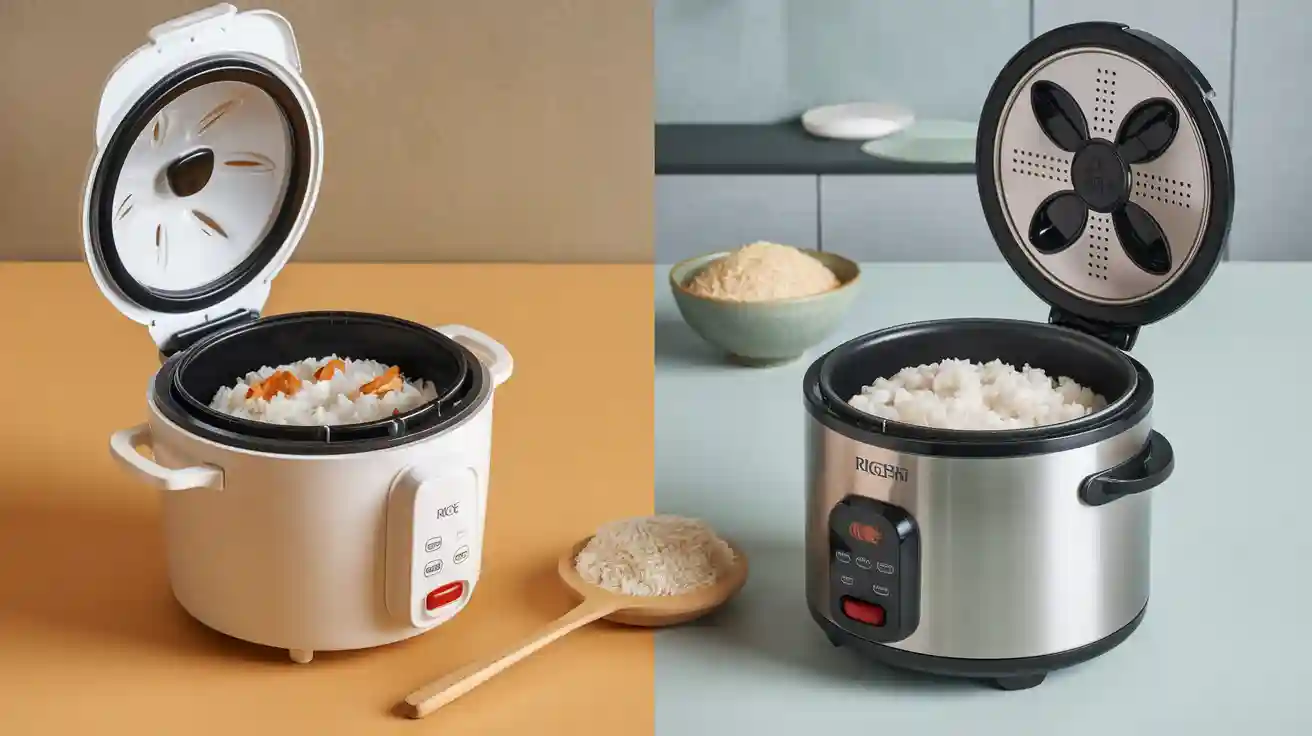
You want the best rice cooker without teflon for your kitchen. Both ceramic and stainless steel rice cookers without teflon give you safer, non-toxic rice cookers. If you focus on health, taste, or easy cleaning, the best rice cooker without teflon changes. Rice cookers without teflon protect your food. Non-toxic rice cookers keep meals safe. The best rice cooker without teflon matches your cooking style and care routine. Choose the best rice cooker without teflon for your needs.
Rice Cookers Without Teflon: Healthier Choices
Non-Toxic Rice Cookers and Safest Food Contact Surfaces
You want to keep your meals safe and free from harmful chemicals. Non-toxic rice cookers help you do that. When you choose rice cookers without teflon, you avoid the risks linked to chemical coatings. Teflon coatings often contain PFAS chemicals. These chemicals can cause health problems like reduced immunity, reproductive issues, allergies, asthma in children, and even some cancers. You do not want these risks in your kitchen.
Ceramic and stainless steel are two of the safest food contact surfaces. Uncoated ceramic rice cookers show almost no heavy metal migration in independent tests. This means your food stays clean and safe. Stainless steel stands out as the safest food contact surface. It resists heat and does not need any chemical coating. You get healthier cooking without harmful chemicals when you use these materials.
Tip: If you want non-toxic cookware, always check for uncoated ceramic or stainless steel. These materials protect your food and your health.
Teflon-Free Rice Cooker Benefits
A teflon-free rice cooker gives you peace of mind. You do not have to worry about chemicals leaching into your food. Non-toxic rice cookers last longer because they do not have coatings that can peel or wear off. You can cook rice, grains, and even steam vegetables without fear of contamination.
Here are some key benefits of rice cookers without teflon:
- You avoid exposure to PFAS chemicals.
- You get the safest food contact surfaces for your family.
- You enjoy easy cleaning and long-lasting performance.
- You support healthier habits with non-toxic rice cookers.
Many families now choose rice cookers without teflon for these reasons. You can make a smart choice for your kitchen and your health.
Ceramic vs Stainless Steel: Comparing Cooking Performance
Rice Quality and Taste
You want every bowl of rice to taste great. The best rice cooker without teflon helps you achieve that goal. Ceramic rice cookers often give you fluffy, evenly cooked rice. The ceramic pot heats gently and holds warmth well. This slow, steady heat helps grains absorb water evenly. You notice that brown rice, white rice, and even mixed grains come out soft and separate. Many people say ceramic rice cookers make rice taste more natural and pure.
Stainless steel rice cookers also deliver good results. The stainless steel pot heats up quickly and cooks rice fast. You get firm, well-cooked grains. Some users find that stainless steel pots can make rice stick a little more, but you can avoid this by rinsing rice well and adding enough water. If you want to know how to cook rice to lower arsenic levels, you can use extra water and drain the rice after cooking. Both ceramic and stainless steel rice cookers let you use this method, which helps you prepare healthy meals for your family.
You may notice a slight difference in taste between the two types. Ceramic pots do not react with food, so you get a clean flavor. Stainless steel also keeps flavors pure, but some people prefer the softer texture from ceramic. If you want the best rice cooker without teflon for taste, ceramic may give you a slight edge, especially for delicate types of rice via arsenic exposure concerns.
Tip: For better rice cookers, always rinse your rice and use the right water-to-rice ratio. This helps both ceramic and stainless steel pots deliver the best results.
Versatility and Food Types
You want a rice cooker that does more than just cook rice. The best rice cooker without teflon should help you make healthy meals with different grains, vegetables, and even proteins. Ceramic rice cookers shine when you cook multi-grain blends, quinoa, or steam vegetables and seafood. The nonstick ceramic pot makes cleanup easy. You can use it for oatmeal or porridge, too. Many users praise ceramic models for their fast cooking and simple controls.
Stainless steel rice cookers offer even more cooking options. You can use them for slow cooking, sautéing, and steaming. Some models let you make soups, stews, and even sauté vegetables before adding rice. The digital controls and preset programs make it easy to try new recipes. Stainless steel pots handle daily use well and support a wide range of foods. If you want better rice cookers for busy families, stainless steel models give you flexibility.
Here is a quick comparison to help you choose:
| Feature/Aspect | Ceramic Rice Cooker (Hamilton Beach) | Stainless Steel Rice Cooker (COMFEE) |
|---|---|---|
| Cooking Functions | Rice, grains, cereals, steaming seafood and vegetables | Rice, steaming, slow cooking, sautéing, oatmeal |
| Pot Material | Removable ceramic pot, PFAS-free nonstick | Non-stick inner pot, stainless steel exterior |
| Cleaning | Dishwasher safe, easy cleanup | Dishwasher-safe, easy cleaning |
| Capacity | Up to 8 cups of rice | Up to 8 cups of rice (2-quart size) |
| Usability | One-touch settings, countdown timer, auto warm | Digital panel, preset programs, simple controls |
| Versatility | Excels in multi-grain cooking and steaming | Supports slow cooking and sautéing |
| User Feedback | Fast cooking, ease of use, multifunctional | Versatile for daily meals, good for small households |
| Limitations | Condensation under lid, vent maintenance | Limited capacity for large families, learning curve for functions |
You see that both types help you prepare healthy meals. Ceramic models work well for grains and steaming. Stainless steel models give you more cooking styles, like slow cooking and sautéing. If you want the best rice cooker without teflon for a variety of foods, stainless steel may suit you better. If you focus on grains and easy cleaning, ceramic is a strong choice.
Note: Both ceramic and stainless steel rice cookers help you make healthy meals. Choose the one that matches your cooking habits and the types of food you enjoy most.
Durability and Maintenance of Non-Toxic Rice Cookers
Longevity and Wear
You want your rice cooker to last for years. Ceramic and stainless steel rice cookers both offer strong durability, but they wear differently over time. Ceramic pots resist scratches and do not rust. You may notice that ceramic can chip or crack if you drop it or use metal utensils. Stainless steel pots handle daily use well. They do not chip or break, and they resist dents. You might see some discoloration or minor scratches after many uses, but these do not affect performance.
If you want a rice cooker that stands up to heavy use, stainless steel gives you peace of mind. You can use it every day without worrying about damage. Ceramic works well if you handle it with care and avoid sudden temperature changes.
Tip: Use wooden or silicone utensils with ceramic pots to prevent chips and cracks.
Ease of Cleaning
You want cleaning to be quick and easy. Ceramic rice cookers often have a smooth, nonstick surface. Food comes off easily with a gentle wipe or a soft sponge. You can usually put the ceramic pot in the dishwasher. Stainless steel pots also clean up well, but rice may stick more if you do not use enough water. Soaking the pot for a few minutes helps loosen stuck grains.
Here is a simple cleaning comparison:
| Feature | Ceramic Pot | Stainless Steel Pot |
|---|---|---|
| Dishwasher Safe | Yes | Yes |
| Stain Resistance | High | Moderate |
| Stickiness | Low | Moderate |
You can keep both types looking new with regular care. Always let the pot cool before washing to avoid damage.
Cost and Value: Finding the Best Rice Cooker Without Teflon
When you shop for the best rice cooker without teflon, you want to balance cost and features. Some models offer simple functions at a low price. Others give you advanced technology and extra settings for a higher cost. You can find a model that fits your budget and cooking needs.
Here is a table to help you compare popular options:
| Rice Cooker Model | Price Range | Key Features | Value Considerations |
|---|---|---|---|
| GreenPan Elite 8-Cup Induction | Mid to High-End | Teflon-free ceramic coating, induction heat | Balances health and performance |
| Hamilton Beach Programmable | Budget | Basic programmable settings | Affordable, great for simple rice cooking |
| Zojirushi Induction Heating | High-End | Advanced induction, precise control | Premium price, professional results |
| Cuckoo CR-0655F | Mid to High-End | Precision cooking, customizable settings | Good for accuracy and special recipes |
| KitchenAid Grain and Rice Cooker | Mid-Range | Durable, versatile | Reliable for many household needs |
You may notice that the best rice cooker without teflon for your home depends on what you want to cook. If you only make white rice, a budget model like Hamilton Beach works well. If you want more control and features, you might choose a high-end model such as Zojirushi. The Spruce Eats found that basic models meet simple needs, but advanced models justify their price with better performance and more options.
Many users prefer the best rice cooker without teflon with ceramic coatings for easy cleaning and durability. You can extend the life of your cooker by hand-washing the pot. When you compare price and features, you see that the best rice cooker without teflon gives you value by matching your cooking style and budget.
Tip: Choose the best rice cooker without teflon that fits your daily habits. You save money and enjoy healthy meals.
Side-by-Side Comparison Table: Ceramic and Stainless Steel

You want to see how ceramic and stainless steel rice cookers compare. The table below helps you choose the best option for your kitchen. You can look at each feature and decide what matters most for your cooking style.
| Feature | Ceramic Rice Cooker | Stainless Steel Inner Pot Rice Cooker |
|---|---|---|
| Cooking Surface | Smooth ceramic | Durable stainless steel inner pot |
| Health Safety | Non-toxic, no metal leaching | Non-toxic, no chemical coatings |
| Rice Texture | Soft, fluffy, even heating | Firm, separate grains, quick heating |
| Stickiness | Low, easy to remove rice | Moderate, rice may stick without rinsing |
| Durability | Can chip or crack | Very strong, stainless steel inner pots last for years |
| Cleaning | Easy, dishwasher safe | Easy, dishwasher safe, may need soaking |
| Versatility | Great for grains, porridge | Works for rice, grains, soups, and more |
| Price Range | Mid to high | Budget to high-end |
Tip: If you want a rice cooker that lasts, a stainless steel inner pot gives you strong performance and easy cleaning. You can use stainless steel inner pots for many types of meals, not just rice.
You see that both options offer safe, non-toxic cooking. Ceramic gives you gentle heat and easy cleanup. A stainless steel inner pot gives you strength and flexibility. You can pick the one that fits your needs best.
How to Choose the Safest Food Contact Surfaces for Your Needs
Prioritizing Health and Safety
You want the best rice cooker without teflon to protect your family’s health. Always check the materials used for the inner pot. Consumer investigations, like the one by Mamavation, show that the safest food contact surfaces include stainless steel and uncoated ceramic. These materials do not contain PFAS, PFOA, or other harmful chemicals. Look for rice cookers that meet toxin-free standards and have certifications. Many customers choose models like the AROMA® Select Stainless® Rice Cooker because they trust the safety of the materials. You can enjoy healthy meals and peace of mind when you pick the right rice cooker.
- Mamavation’s criteria for safe rice cookers:
- No PFAS or mystery coatings
- Stainless steel or uncoated ceramic inner pots
- Low heavy metal migration in lab tests
Tip: Certifications such as HACCP or food-grade labels help you find the best rice cooker without teflon.
Focusing on Taste and Texture
You want rice that tastes great and feels just right. The best rice cooker without teflon helps you get soft, fluffy grains or firm, separate rice. Ceramic pots often give you a gentle, even heat. Stainless steel pots heat up quickly and work well for many types of rice via arsenic exposure. If you want to know how to cook rice to lower arsenic levels, both ceramic and stainless steel models let you use extra water and drain the rice. Better rice cookers let you adjust settings for different grains, so you always get the taste and texture you like.
Considering Maintenance and Cleaning
You want a rice cooker that is easy to clean and lasts a long time. Regular cleaning keeps your rice cooker safe and working well. Always follow the manufacturer’s instructions. Use soft sponges and avoid harsh cleaners. Check the inner pot for chips or scratches. Use wooden or silicone utensils to protect the surface. Descale your rice cooker with vinegar to remove mineral buildup. Store it in a cool, dry place. These steps help you keep the best rice cooker without teflon in top shape for years.
- Maintenance tips:
- Clean after each use
- Avoid metal utensils
- Inspect for damage
- Descale regularly
Budget and Value for Money
You want value when you buy the best rice cooker without teflon. Stainless steel models often cost less and last longer. Ceramic models may cost more but offer easy cleaning and gentle cooking. Look for features like dishwasher-safe pots, one-touch controls, and automatic keep-warm settings. Customer reviews often mention that the safest food contact surfaces lead to fewer worries and better meals. Choose a rice cooker that fits your budget and helps you make healthy meals every day.
Pros and Cons of Ceramic Non-Toxic Rice Cookers
Advantages
You get many benefits when you choose ceramic non-toxic rice cookers. These cookers use ceramic non-stick coatings, which help you avoid harmful chemicals found in traditional nonstick surfaces. You protect your health and keep your food safe. Experts say ceramic non-stick coatings help preserve nutrients and prevent toxic substances from leaching into your meals. Many users report that rice tastes better and has a more natural flavor.
You also join a growing group of health-conscious consumers. A recent survey shows that 75% of people worry about the safety of food packaging and cookware. The demand for eco-friendly products, like ceramic-coated alternatives, rises by 20% each year. You can see this trend in customer reviews. For example, Zojirushi ceramic rice cookers often receive ratings as high as 4.8 out of 5 stars. People praise the peace of mind and improved lifestyle these cookers bring.
| Consumer Concern or Trend | Statistic |
|---|---|
| Concern about food packaging safety | 75% of consumers |
| Annual increase in preference for eco-friendly products | 20% yearly |
Tip: If you want a rice cooker that supports your healthy lifestyle, ceramic non-toxic models offer a strong choice.
Drawbacks
You should also consider some drawbacks before you buy. Ceramic pots can chip or crack if you drop them or use metal utensils. You need to handle them with care. Some ceramic non-toxic rice cookers cost more than basic models. If you want a truly natural option, uncoated unglazed ceramic pots exist, but they may require extra care and can be harder to find.
Ceramic non-stick coatings may wear down over time, especially if you use harsh cleaners or scrubbers. You should always follow the cleaning instructions to keep your cooker in good shape. Some users notice that ceramic pots heat up more slowly than metal ones. This can mean longer cooking times for certain recipes.
Note: If you want a rice cooker that lasts for years, remember to use gentle utensils and avoid sudden temperature changes.
Pros and Cons of Stainless Steel Teflon-Free Rice Cookers
Advantages
You get many benefits when you choose a stainless steel teflon-free rice cooker. Stainless steel stands out as one of the safest materials for cooking. It does not react with food, so you avoid unwanted flavors or chemicals. You can use this type of rice cooker every day without worrying about coatings peeling or wearing off. Stainless steel pots resist dents, scratches, and rust. You can clean them easily, even in the dishwasher.
Many families like stainless steel because it lasts for years. You can use metal utensils without damaging the pot. Stainless steel also heats up quickly, so you save time when cooking rice or other grains. You can cook many types of food, such as soups, stews, and steamed vegetables. This makes your rice cooker more useful in the kitchen.
Tip: Stainless steel rice cookers work well for people who want a strong, long-lasting, and safe cooking surface.
Drawbacks
You should know about some drawbacks before you buy. Stainless steel pots can make rice stick if you do not use enough water or if you skip rinsing the rice. Cleaning stuck rice may take extra time. Some people notice that rice cooked in stainless steel feels firmer or less fluffy than rice from ceramic pots.
Stainless steel rice cookers may cost more than basic nonstick models. You may also see water spots or discoloration after many uses, but these do not affect safety. If you want soft, delicate rice every time, you might prefer a ceramic option.
| Drawback | Impact on Use |
|---|---|
| Rice may stick | Needs soaking or scrubbing |
| Firmer rice texture | Less fluffy for some grains |
| Higher price | More investment up front |
| Water spots/discoloring | Cosmetic, not harmful |
Note: You can reduce sticking by rinsing rice well and using the right amount of water.
You want the best rice cooker without teflon for your kitchen. Ceramic models give you gentle cooking and easy cleaning. Stainless steel options offer strength and versatility. If you focus on health, choose the best rice cooker without teflon with safe materials. For convenience or savings, pick the best rice cooker without teflon that matches your habits. Always select the best rice cooker without teflon for your health goals.
FAQ
Can you use metal utensils in ceramic or stainless steel rice cookers?
You should avoid metal utensils in ceramic pots to prevent chips. You can use metal utensils in stainless steel pots without worry.
Does rice stick more in stainless steel rice cookers?
Yes, rice can stick more in stainless steel pots. Rinse rice well and use enough water to reduce sticking.
Are ceramic and stainless steel rice cookers dishwasher safe?
Most ceramic and stainless steel inner pots are dishwasher safe. Always check your rice cooker’s manual for cleaning instructions.


